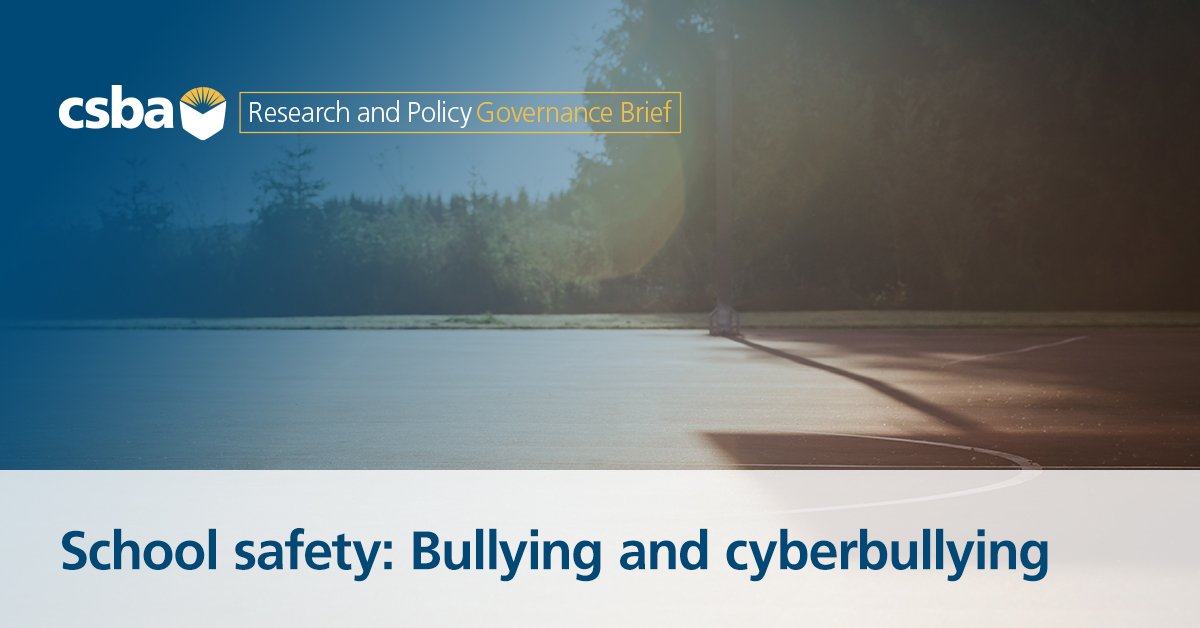By Angela Asch
October is National Bullying Prevention Month, an opportune time to educate and raise awareness on what bullying is and how bullying affects school climate, students’ well-being and academic achievement. Bullying and cyberbullying impact a student’s ability to learn and can have damaging consequences on their self-esteem, physical and mental health, and can lead to school avoidance. These impacts combine to negatively impact their academic achievement and other outcomes.
CSBA’s new bullying and cyberbullying brief provides bullying and cyberbullying statistics and prevention resources. Examples from local educational agencies implementing awareness campaigns, community education, training for staff, and educating on and using anonymous reporting systems to reduce harm are also included. Additionally, CSBA also has a webpage on bullying, discrimination and harassment with more information and prevention resources.
Bullying prevention is a whole school, district and community effort. LEAs can create safe and supportive school environments and positive climates by:
- educating students staff, and families about bullying and cyberbullying;
- training staff to identify bullying behaviors and how to respond;
- providing resources for students who have engaged in bullying behavior and students impacted by bullying;
- and implementing a districtwide approach to prevention.
Assembly Bill 2291 (2019) requires all LEAs to adopt policies and practices to prevent bullying and cyberbullying and requires that the California Department of Education (CDE) maintain a list of bullying and cyberbullying training and resources. Bullying prevention policies and practices support mental health and wellness, academic achievement and a positive school climate.
What is bullying and why does it matter?
Bullying is a form of youth violence. According to StopBullying.Gov, an anti-bullying resource page maintained by the U.S. Department of Health and Human Services, bullying is, “unwanted, aggressive behavior among school-aged children that involves a real or perceived power imbalance. The behavior is repeated or has the potential to be repeated, over time. Both kids who are bullied and who bully others may have serious, lasting problems.”
StopBullying.Gov defines cyberbullying as an act that, “includes sending, posting, or sharing negative, harmful, false, or mean content about someone else. It can include sharing personal or private information about someone else causing embarrassment or humiliation. Some cyberbullying crosses the line into unlawful or criminal behavior.”
Cyberbullying can occur on any digital device and can be persistent, permanent, and hard to notice. Digital devices allow for 24-hour communication and access to information; therefore, cyberbullying behavior may persist for longer than an in-person altercation. Online information is often permanent and can remain public indefinitely. Educators and family members may not be aware of the cyberbullying taking place, and victims may not know about it until someone tells them or shows them the offending post, so it may be harder to notice if a student is abusing another person or suffering abuse.
California anti-bullying laws include cyberbullying acts that occur on or off school sites, and require LEAs to notify parents and families when a student is involved in harassment, intimidation, cybersexual bullying, or bullying, and must share information on statewide resources with parents and families regarding harassment, intimidation, cybersexual bullying, and bullying. CSBA offers sample policies for bullying, harassment and discrimination and CDE also provides more information, policies and complaint procedures for specific student populations.
Bullying is a significant public health concern that, if not prevented or stopped, can lead to long-lasting consequences such as suicide ideation, self-harm, drug and alcohol use, and a higher likelihood of dropping out of school. Students who feel connected to their school community and peers are at a lower risk of harming themselves or others.
Bullying data on California students
The most recent survey data from Kidsdata.org, a program of the Population Reference Bureau (PRB), for the 2017–19 school years, found that one in four students in seventh, ninth and 11th grades reported being bullied or harassed at school. During that same period, 20 percent of school staff in elementary schools and 44 percent of middle school staff reported that bullying and harassment were a moderate or severe problem at their school.
Biases toward particular student groups impact the rate of bullying and harassment. Forty-four percent of LGBTQ youth reported being bullied or harassed because of their identity or perceived identity. Therefore, it is imperative to educate students, staff, and families about implicit and explicit biases and provide training on inclusive practices and behaviors to create a positive school climate.
Resources for bullying prevention
Bullying Prevention Training & Resources – School Environment (CA Dept of Education)
National Bullying Prevention Month – National Bullying Prevention Center (pacer.org)
National Bullying Prevention Month | The National Child Traumatic Stress Network (nctsn.org)
School bus bullying prevention
Angela Asch is CSBA principal research manager in the Research and Education Policy Development Department





